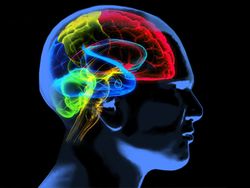Memory
Introduction[edit | edit source]
Memory is defined simply as the capacity to store and retrieve information[1]. It is a sum of the processes that entail acquiring, storing, retaining and eventually retrieving information[2]. Contrary to popular belief, memory does not deteriorate with age. Memories are stored through the strengthening of synaptic connections between nerve cells. The hippocampus, the parahippocampal gyrus, the fornix, mammillary bodies, the cingulate gyrus are structures concerned with memory function.
Types of Memory[edit | edit source]
Three main categories of memory have been identified namely as:
- Sensory
- Short-term and
- Long-term memory[1]
Sensory Memory[edit | edit source]
This form of memory involves an entirely unconscious effort to occur. Sensory memory (SM) is the shortest form of memory. It involves the capacity to store impressions after having ended the original stimulus. It is responsible for receiving stimulus from the five senses which are stored briefly but accurately. Storage of this kind of memory is done automatically and is unable to be elongated through rehearsal. SM translates into short term memory through the process of attention, which involves selectively concentrating on one aspect of the environment while ignoring other elements[3].
Short-Term Memory[edit | edit source]
Short-term memory (STM) may be defined as the maintenance of information over a brief period which often occurs in seconds and results from conscious maintenance of sensory stimuli within this time frame[4]. It is also known as primary or working memory. It involves remembering and processing information at the same time. Only a small amount of information is stored for a short time ranging from 15 seconds to 1 minute. STM becomes long-term memory when information is consciously stored through a process known as consolidation. This process is enhanced through repetition, associating new information with previous knowledge and/or a subject of keen interest[3]. The prefrontal cortex is the primary area of the brain responsible for STM.
Long-Term Memory[edit | edit source]
Long-term memory (LTM) is the final stage involved in processing memory and is largely a store of previous events[5]. It refers to memories that have become stable and unyielding to interference[4]. It is otherwise referred to as secondary memory. Recall from LTM is usually done with ease when compared to that from STM. Information stored in LTM can last between months to decades[6].
There are basically two types of LTM namely: explicit and implicit memory.
Explicit Memory: Also known as declarative memory, explicit memory refers to memories that are consciously brought to the fore. It is further divided into: episodic memory and semantic memory[6]. Explicit memories are controlled by the hippocampus[7].
- Episodic Memory refers to memories that require knowledge of the details of events as well as the time and place they took place. An example of this type of memory will be the first time venturing at a quest.
- Semantic Memory deals with the storage of factual information such as the meaning of words.
Implicit Memory: Otherwise known as non-declarative or procedural memory is the memory that relates with bodily movements in carrying out activities such as writing, driving and swimming. Four types of this memory exist. They are as follows:
- Procedural Memory is memory concerned with knowing how to do things. It is automatic and simply a memory of motor skills. The striatum is the brain area responsible for its function[7].
- Associative Memory as the name implies refers to memories that are stored and retrieved by association. Areas of the brain involved in this type of memory are the amygdala and cerebellum[7].
- Non-Associative Memory is associated with learning of new behaviours through repeated exposure to a single type of stimuli.
- Priming is the effect a previous memory or experience has on new information.
Stages of Memory Formation[edit | edit source]
There are three stages involved in memory formation namely:
- Encoding or acquisiion is the initial stage of memory formation and is the stage where new information is learnt.
- Storage involves retaining information initially exposed to over varying lengths of time depending on whether the memory store is long-term or short term.
- Retrieval also known as recall involves bringing stored information to consciousness.
How to Improve Memory[edit | edit source]
A few ways which may help memory include: a healthy diet; regular exercise; not smoking ;maintaining blood sugar, cholesterol and blood pressure within normal ranges and avoiding sedentariness. A book review by Sleister (2014) revealed that retrieval practice, which is a method to recall information previously learned helps to consolidate memory as well as improve it[8].
Disorders of Memory[edit | edit source]
Include:
- Dementias
- Amnesias
References[edit | edit source]
- ↑ 1.0 1.1 Zlotrik G, Vansintjan A. Memory: An Extended Definition. Front Psychol 2019; 10: 2523.
- ↑ Kendra C. Verywell mind: What is Memory? [Internet] 2020 [cited 15 May 2020]. Available from: https://www.verywellmind.com/what-is-memory-
- ↑ 3.0 3.1 The Human Memory. Sensory Memory. Available from: https://human-memory.net/sensory-memory/ (accessed 29 March 2021).
- ↑ 4.0 4.1 Brem AK, Ran K, Pascual-Leone A. Learning and memory. Handb Clin Neurol 2013; 116:693-737
- ↑ Cowan N. What are the differences between long-term, short-term, and working memory? Prog Brain Res. 2008; 169: 323-338.
- ↑ 6.0 6.1 The Human Memory. Long-Term Memory. Available from:https://human-memory.net/long-term-memory/ (accessed 30 March 2021).
- ↑ 7.0 7.1 7.2 Stern SA, Alberini CM. Mechanisms of Memory Enhancement. Wiley Interdiscip Rev Syst Biol Med. 2013 5(1): 37–53.
- ↑ Sleister HM. Evidence-Based Strategies to Improve Memory and Learning. J Microbiol Biol Educ. 2014; 15(2): 336–337.







